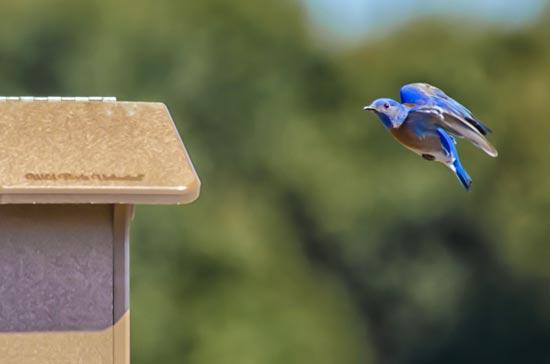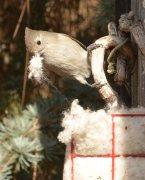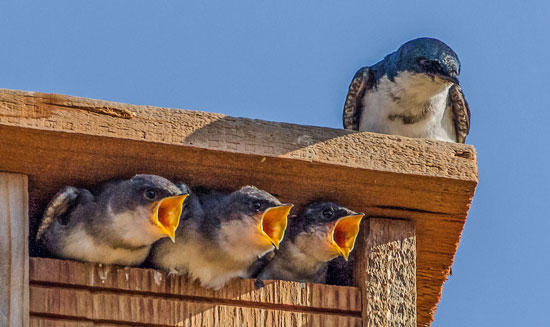Now Hiring
Wild Birds Unlimited of Novato is now hiring for the position of part-time Sales Associate.
For more information, see this page or submit an application via our listing on Indeed. Applications and/or resumes may also be submitted to [email protected] or in-person at our Novato location. For more information, contact Molly Brown by phone at (415) 893-0500 or at [email protected].
Attracting Nesting Birds
 Western Bluebird entering nest box - local picture by Robert Rus
Western Bluebird entering nest box - local picture by Robert Rus
Nesting Season Basics
As with many other animals, most birds concentrate their reproductive activity during spring and summer, when food is most abundant, weather is less challenging, and longer days give more time for foraging. For a typical small songbird, nest construction might take a week or two, laying 4–8 eggs takes another week or so, incubation lasts about two weeks, and then another few weeks is spent feeding the young birds in the nest as they grow rapidly to adult size before fledging, or leaving the nest. Young birds will not return to the nest after fledging, but will usually associate with their parents for several weeks or more to receive supplemental food as they gradually become more self-sufficient.
In the Bay Area's mild climate, the "spring nesting season" can start quite early in the year. Hummingbirds and owls can begin establishing territories or performing courtship behavior in December, a few songbirds start singing in January, and the first round of cavity-nesting songbirds can start nest-building in late February. In the backyard, some of these behaviors we can only witness, but there are other aspects of the nesting season in which we can actively participate, helping to support and encourage vibrant bird populations.
Bird Houses
Bird houses, or nesting boxes, are the most familiar part of helping birds during nesting season. Certain bird species build their nests in natural or woodpecker-excavated cavities in trees. With the scarcity of mature and dead trees in many residential neighborhoods, suitable cavities are often in short supply, making the lack of appropriate nest sites a limiting factor to bird populations even when there is adequate territory and food supplies. And in many cases, the nesting boxes supplied by humans can be superior to those tree cavities that do exist: small, species-specific entrance holes and careful construction limit the entrance of water and predators.
Local woodworkers: If you make your own nesting boxes and are interested in selling them in our Novato store, take a look at our Bird House Requirements information sheet and get in touch!
Which birds will use bird houses?
Note that many birds will build their own nests in trees or on the ground and will not use houses. Common backyard birds fall into several categories based on their nesting habits:
- Ground-nesting birds like quail, spotted towhees, or juncos will not use houses
- Cup-nesting birds like finches, hummingbirds, jays, or mockingbirds build an open cup in a tree and will not use houses
- Mud-nesting birds like black phoebes or barn swallows often nest under eaves and may use a "nesting shelf," but will not use traditional bird houses
- Cavity-nesting birds like oak titmice, Bewick's wrens, chestnut-backed chickadees, western bluebirds, tree swallows, and violet-green swallows nest in the wild in natural or woodpecker-excavated tree cavities – these are the "big six" birds that are most likely to use houses in the San Francisco Bay Area. A few others, like woodpeckers and nuthatches, also can use houses, but often prefer natural tree sites.
Tree swallows awaiting feeding - local photo by Susie Kelly
House types
The "big six" songbirds mentioned above (titmouse, wren, chickadee, bluebird, tree swallow, violet-green swallow) can all nest in a normal-sized or "bluebird" house. The most important variable in determining which birds will use a house is the entrance size. A 1 1/2" or 1 9/16" opening will allow all of the above to enter, while a smaller box with a 1 1/4" entrance will limit occupants to wrens and chickadees (titmice will occasionally squeeze in a 1 1/4" hole). There are also a few other kinds of nesting boxes:
- Big boxes: A few larger birds in our area will also use specially-sized, larger boxes. Northern flickers and western screech-owls can use a medium-large boxes, while barn owls will use very large boxes. The box dimensions, hole size, and positioning are important, so come in to the store to make sure you choose an appropriate box for the birds in your yard.
- Nesting shelves: The mud-nesting birds mentioned above (black phoebe and barn swallow) favor sheltered sites under eaves and will use a flat or cup-shaped nesting platform. House finches, mourning doves, or robins will occasionally use these platforms as well.
Where do I put it?
There are myriad ways to mount nesting boxes: trees, free-standing poles, buildings, or fence posts may be appropriate locations. Remember that birds are looking for a safe, secluded spot to raise their vulnerable young: some distance from the busyness of birdfeeders and areas of high human traffic will be strongly preferred. Also keep in mind that, in general, securely mounting a box is far more attractive to birds than having one hanging and swaying in the wind. For more specific suggestions, come talk to us for advice on how to choose and place a nesting box to attract the birds that you have in your yard!
Five Reasons to Put up a Bird House1. Attract different birds 2. Help birds - make up for lost trees 3. Employ insect-eaters 4. See babies 5. It's easy! |
 Nest-Building Materials
Nest-Building Materials
Both birds that use nesting boxes and those that build open cup nests need materials with which to construct their nests. Naturally, birds will use grasses, twigs, plant fibers, animal hairs, and assorted other items. Putting up one of our balls of cotton or alpaca wool nesting material (or the DIY version of yarn and hair - but not dryer lint), allows you to watch different species as they work on nest construction. See our most popular nest building material in our online store.
Left: Oak Titmouse gathering nesting material. Local picture by Susie Kelly.
Special Foods

Foods containing calcium are particularly valuable at this time of year. Human children are often given milk to drink in an effort to build strong bones – the same applies to young birds, whose period of growth is compressed into a much shorter space of time. Eggs also require calcium – thin or weak eggshells can often prevent reproductive success. Our popular Bark Butter is enriched with calcium to help avoid this, as are our insect suet cakes and suet balls from Pacific Bird & Supply.
Protein rich foods are also very important for feeding young, growing birds. In nature, many birds that eat plants and seeds through much of the year will catch insects in spring to feed their young. This natural tendency can be accommodated by offering mealworms, which are especially popular when feeding nestlings.
Right: Western Bluebird with mealworm delivery. Local photo by Christine Hansen.


